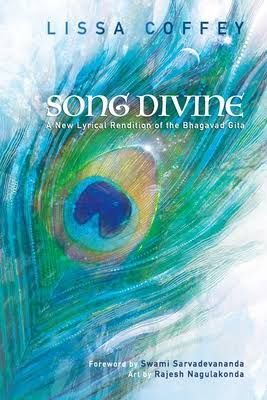A Divine Song for Today
Patti Conklin • May 17, 2022
What We Can Learn From an Ancient Text

The Bhagavad Gita was written in India by the great sage Vyasa 5,000 years ago. It is the second-bestselling book, and second-most-translated book in the world, even now. The Gita, as it is commonly referred to in spiritual circles, was first translated into English in 1785 by Charles Wilkins and then made its way to the United States and into the hands of Ralph Waldo Emerson and Henry David Thoreau. The Bhagavad Gita is often credited as the inspiration for the Transcendentalist Movement of the 1930s and 40s. Today there are more than 270 English translations of the Bhagavad Gita. There’s no doubt that this book from ancient India has had a profound effect on western society. This book is a small part of the larger epic “Mahabharata” or “Great India.” The story in the Mahabharata follows the rivalry between two sets of cousins from the same family. When it finally comes to war, our hero, Arjuna, has a crisis of conscience, and questions his role in the battle. He breaks down and begs his friend and mentor for advice about what he should do. The Bhagavad Gita is made up of teachings that Krishna (God) gave to Arjuna (representing humankind) on the battlefield.

Sri Ramakrishna, revered as one of the greatest spiritual teachers of all time, and one of the most prominent religious figures of India in the nineteenth century, had the highest regard for the Bhagavad Gita. Ramakrishna taught how to live the lessons in the Gita. He said: “Utter the word Gita, in quick succession, several times. It is then virtually pronounced as Tagi, Tagi, which means one who has renounced the world for the sake of God. Thus, in one word, Gita teaches, RENOUNCE. Renounce everything, and fix the mind on Lord.”
Ramakrishna’s disciple and student, Swami Vivekananda, carried just two books with him as he traveled throughout India as a wandering monk: Imitation of Christ and Bhagavad Gita. When Vivekananda addressed the Parliament of World Religions in Chicago in 1893, he emphasized the non-sectarian philosophy of the Bhagavad Gita. In his opening address, Vivekananda quoted this verse that Krishna speaks from the Gita: "Whosoever comes to Me, through whatsoever form, I reach him; all men are struggling through paths which in the end lead to Me."
“Bhagavad Gita” translates from Sanskrit to mean “Song of God” or “Divine Song.” It was written in verse, with rhythm and rhyme, so that it could be memorized and recited, or sung. However, that “beat” is lost when the words are translated into other languages, including English. With this in mind, I thought that there must be some variation of the Bhagavad Gita that had been translated into English, that had both rhythm and rhyme, so that I could memorize the verses more easily. Swami Sarvadevananda always advised us about how wonderful it is to know the verses by heart, and encouraged us to memorize them. I set out to find such a translation, but came up empty. And that’s when I decided to create it myself.
And now in the twenty-first century, Song Divine, this particular version of the Bhagavad Gita, has come across your computer screen. This is not a coincidence, it is a gift. This is an important opportunity that somehow you have asked for, and that you are ready for. I encourage you to read the Gita, study it, and learn from it. Swami Vivekananda wrote: “Please read the Gita every day to the best of your opportunity.” Swami Premananda was another disciple of Sri Ramakrishna who taught the beauty and power of the lessons in the Gita. When his student, Swami Gnaneswarananda told his teacher that he had read the Gita, Swami Premananda said: “My boy, say I am reading it. Never say I have read the Gita. One can never finish reading the Gita.” I agree with him. There is always more to discover in this beautiful text.
The original Bhagavad Gita contains 700 verses. Song Divine contains 417, so it is a shortened version. What I’ve left out is a lot of the background history about the families involved in the war that comes in Chapter One and the first part of Chapter Two. There are also a few other characters in the Bhagavad Gita, but I chose to focus on Krishna and Arjuna exclusively as it is in their dialogue that we find all of the spiritual lessons. I’ve also left out some of the verses that explain the caste system, as I felt that this didn’t apply to a modern, western audience. After the book was published, I approached my good friend, music producer and composer David Vito Gregoli, about setting each chapter to music as a song. And three years later, Song Divine: The Bhagavad Gita ROCK OPERA was born.
Now, probably more than ever, what people worldwide are all searching for is peace of mind. We want to be happy, and to be successful. We strive feverishly to obtain whatever it is outside of us that we think it will take to make us happy or successful. But what we don’t understand is that peace of mind is where it all starts. When the mind is calm and tranquil, despite any conditions or situations that we are in, then this provides fertile ground on which happiness and success can grow. It is my wish that Song Divine, with Krishna’s wise and beautiful words, helps you to know who you are. There’s nothing more important than that. Know who you are, and the peace of mind that you have been seeking is yours.
Find out more about Song Divine here. Find out more about Lissa Coffey here.
Ramakrishna’s disciple and student, Swami Vivekananda, carried just two books with him as he traveled throughout India as a wandering monk: Imitation of Christ and Bhagavad Gita. When Vivekananda addressed the Parliament of World Religions in Chicago in 1893, he emphasized the non-sectarian philosophy of the Bhagavad Gita. In his opening address, Vivekananda quoted this verse that Krishna speaks from the Gita: "Whosoever comes to Me, through whatsoever form, I reach him; all men are struggling through paths which in the end lead to Me."
“Bhagavad Gita” translates from Sanskrit to mean “Song of God” or “Divine Song.” It was written in verse, with rhythm and rhyme, so that it could be memorized and recited, or sung. However, that “beat” is lost when the words are translated into other languages, including English. With this in mind, I thought that there must be some variation of the Bhagavad Gita that had been translated into English, that had both rhythm and rhyme, so that I could memorize the verses more easily. Swami Sarvadevananda always advised us about how wonderful it is to know the verses by heart, and encouraged us to memorize them. I set out to find such a translation, but came up empty. And that’s when I decided to create it myself.
And now in the twenty-first century, Song Divine, this particular version of the Bhagavad Gita, has come across your computer screen. This is not a coincidence, it is a gift. This is an important opportunity that somehow you have asked for, and that you are ready for. I encourage you to read the Gita, study it, and learn from it. Swami Vivekananda wrote: “Please read the Gita every day to the best of your opportunity.” Swami Premananda was another disciple of Sri Ramakrishna who taught the beauty and power of the lessons in the Gita. When his student, Swami Gnaneswarananda told his teacher that he had read the Gita, Swami Premananda said: “My boy, say I am reading it. Never say I have read the Gita. One can never finish reading the Gita.” I agree with him. There is always more to discover in this beautiful text.
The original Bhagavad Gita contains 700 verses. Song Divine contains 417, so it is a shortened version. What I’ve left out is a lot of the background history about the families involved in the war that comes in Chapter One and the first part of Chapter Two. There are also a few other characters in the Bhagavad Gita, but I chose to focus on Krishna and Arjuna exclusively as it is in their dialogue that we find all of the spiritual lessons. I’ve also left out some of the verses that explain the caste system, as I felt that this didn’t apply to a modern, western audience. After the book was published, I approached my good friend, music producer and composer David Vito Gregoli, about setting each chapter to music as a song. And three years later, Song Divine: The Bhagavad Gita ROCK OPERA was born.
Now, probably more than ever, what people worldwide are all searching for is peace of mind. We want to be happy, and to be successful. We strive feverishly to obtain whatever it is outside of us that we think it will take to make us happy or successful. But what we don’t understand is that peace of mind is where it all starts. When the mind is calm and tranquil, despite any conditions or situations that we are in, then this provides fertile ground on which happiness and success can grow. It is my wish that Song Divine, with Krishna’s wise and beautiful words, helps you to know who you are. There’s nothing more important than that. Know who you are, and the peace of mind that you have been seeking is yours.
Find out more about Song Divine here. Find out more about Lissa Coffey here.










